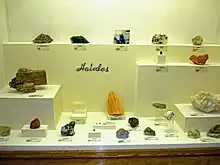Halide
In chemistry, a halide (rarely halogenide[1]) is a binary chemical compound, of which one part is a halogen atom and the other part is an element or radical that is less electronegative (or more electropositive) than the halogen, to make a fluoride, chloride, bromide, iodide, astatide, or theoretically tennesside compound. The alkali metals combine directly with halogens under appropriate conditions forming halides of the general formula, MX (X = F, Cl, Br or I). Many salts are halides; the hal- syllable in halide and halite reflects this correlation. All Group 1 metals form halides that are white solids at room temperature.
A halide ion is a halogen atom bearing a negative charge. The halide anions are fluoride (F−), chloride (Cl−), bromide (Br−), iodide (I−) and astatide (At−). Such ions are present in all ionic halide salts. Halide minerals contain halides.
All these halides are colourless, high melting crystalline solids having high negative enthalpies of formation.
Tests
Halide compounds such as KCl, KBr and KI can be tested with silver nitrate solution, AgNO3. The halogen will react with Ag+ and form a precipitate, with varying colour depending on the halogen:
For organic compounds containing halides, the Beilstein test is used.
Uses
Metal halides are used in high-intensity discharge lamps called metal halide lamps, such as those used in modern street lights. These are more energy-efficient than mercury-vapor lamps, and have much better colour rendition than orange high-pressure sodium lamps. Metal halide lamps are also commonly used in greenhouses or in rainy climates to supplement natural sunlight.
Silver halides are used in photographic films and papers. When the film is developed, the silver halides which have been exposed to light are reduced to metallic silver, forming an image.
Halides are also used in solder paste, commonly as a Cl or Br equivalent.[3]
Synthetic organic chemistry often incorporates halogens into organohalide compounds.
Compounds

Examples of halide compounds are:
- Sodium chloride (NaCl)
- Potassium chloride (KCl)
- Potassium iodide (KI)
- Lithium chloride (LiCl)
- Copper(II) chloride (CuCl2)
- Silver chloride (AgCl)
- Calcium chloride (CaCl2)
- Chlorine fluoride (ClF)
- Organohalides
- Bromomethane (CH3Br)
- Iodoform (CHI3)
- Hydrogen chloride (HCl)
- Hydrogen bromide (HBr)
See also
References
- "Definition of HALOGENIDE". www.merriam-webster.com. Retrieved 2022-01-07.
- AgF can solve in water.
- "Halogen-Free Solder Paste" (PDF). Archived from the original (PDF) on 2012-03-17. Retrieved 2011-03-21.